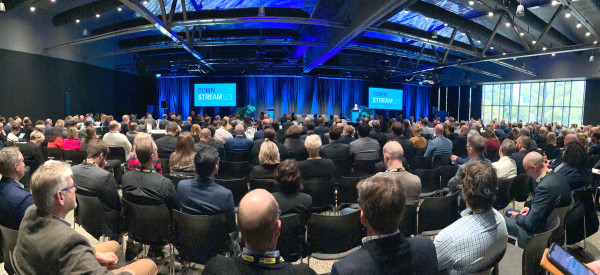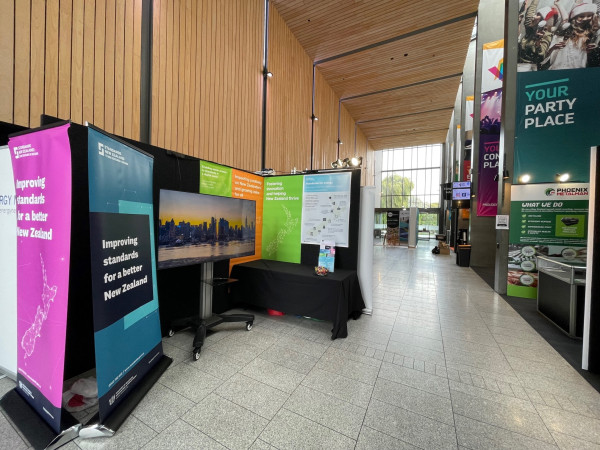Key takeaways from the energy sector at Downstream
Our attendance at this year’s Downstream event in Lower Hutt gave insights into the priorities and focus within the energy sector.

Audience at Downstream
Downstream, the energy sector's annual strategic forum now in its 12th year brought together around 400 international influencers and local representatives from across the New Zealand energy industry
New Zealand is preparing for its largest energy transition in more than 100 years and the industry is gearing up for it. Generating enough energy – particularly with the growing shift towards electric vehicles and moving away from fossil fuels – remains a priority to ensure energy resilience. There is a call to action to accelerate the transition to a low emissions future through what Cristiano Marantes – Chief Executive, Ara Ake, termed as 'collaborACTION'.
Distributed generation
One thing is clear, for resilience a single solution would not be the answer to our future energy needs. Rather a raft of solutions including battery options for dry hydrological years. Distributed generation – that being energy from smaller grid-connected resources – is set to play a key role in how we optimise this country’s ongoing energy needs. This may be in the form of offshore wind farms and large PV installations and hydrogen.
Growing and maintaining our energy infrastructure (panel discussion)
To meet our carbon net zero demands by 2050 there is a necessity for incremental increases including generation to 4.8 GW by 2030. Projects exist in various stages in the pipeline to help address this with BCG (Boston Consulting Group) suggesting as much as 10.7 GW sitting in the system waiting to be built. Many of these projects may likely see a shift in our landscape.
Transpower’s pipeline to 2030 includes delivery of 70% by solar, 16% by wind, 4% by geothermal, and 2% via battery storage. However, with battery storage very low the reliance on other sources of generation will be very intermittent. The land requirement for the future planned solar generation of over 6,500 MW equates to only 94km2, so it doesn’t take up much land area. The critical thing is that we need to get 100% renewable by 2030, however, many challenges still exist.
Meridian Energy on challenges
Meridian Energy presented some of the challenges facing the implementation of large projects across the country.
Consenting timeframes and costs remain major challenges facing all renewable energy projects with timelines sitting at between 1-10 years. With NZ infrastructure developers spending around $1.29 billion each year on getting projects consented to (covering council fees, expert and legal fees, and internal staffing costs) and a 50% improvement in resource consent processing times is needed if we are to reach our 2050 targets. If not the risk liability in emissions charges will be between $5 and $16 bn by 2050.
Minister's Speech – Dr. Megan Woods
Hon. Dr. Megan Woods Minister of Energy and Resources presented on how energy resilience is extremely important given the recent storms across the Motu.
Government is committed to long-term work of strategic change, including making the most of renewable resources, to improve and deploy more energy-efficient, and clean technology and innovation. All parties are signed up to the emissions reduction targets.
New Zealand’s battery project, established in 2020 to find innovative solutions to the 'dry year problem', when hydroelectric lakes run low, is under review. New Zealand needs 3-5 TWh (terawatt hour) of storage or about 10% of our current consumption. A suite of alternatives is being sought to that proposed for Lake Onslow.
Lake Onslow pumped hydro storage option - MBIE website(external link)
Without a resolution, the costs of emissions are not sustainable at over $1 billion per year of using gas and coal. The Government Investment in Decarbonising Industry (GIDI) Fund will be boosted to $650m (over 4 years) to accelerate decarbonisation of industry.
Projects include replacing fossil-fuel boilers with biomass boilers, the use of industrial high-temperature heatpumps as well as heat recovery applications. This equates to $63m in GIDI Funding for the first three rounds across 51 major industrial decarbonisation projects which catalysed $100m in private funding. From these projects, a potential 7.1m tonnes of CO2, equivalent to removing 130, 000 cars from the road, would be kept out of the environment.
A progressive gas transition plan is under review to understand the challenges around phasing out of natural gas by 2035. Offshore renewable wind farms are highly desirable because average wind speeds are higher than most other places on land. This is a key priority with consultation happening in two stages on the dedicated regulatory regime.
Hydrogen is also seen as a complementary tool to carbon emission reduction. That is why the government is developing the H2 Roadmap to clarify the role it will play in the wider energy sector and how the government can enable adoption. There will be an interim roadmap developed for mid-FY2023/24 and a final roadmap end of FY2023/24 that feeds into the Energy Strategy signaling the pathway to renewable energy.
Standards reflecting the macro environment
Standards New Zealand is involved with several projects that will help shape some of this work ahead. From the suite of publicly available specifications (PASs) for biomass boilers and high-temperature heat pumps, to EV charging for the Energy Efficiency and Conservation Authority (EECA) to the hydrogen standards framework and implementation strategy report for WorkSafe New Zealand – Energy Safety, any new initiatives can use standards to ensure safety, reliability, and efficiency based upon international good practice and the input of experts from across the sector.

SNZ's booth ready to connect with delegates
